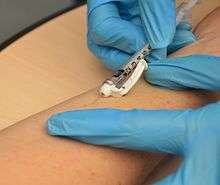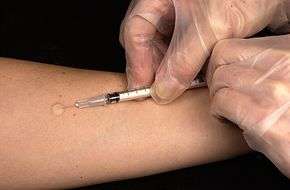Intradermal injection


Intradermal injection (ID) is s shallow or superficial injection of a substance into the dermis, in between the epidermis and the hypodermis (subcutis, subcutaneous or adipose layer). This route is relatively rare compared to subcutaneous injections (SC) and intramuscular injections (IM), and used only when certain therapies, like tuberculin and allergy tests, require the specific benefits of this route of administration and where easier to use SC and IM injections have no effect. Specific benefits are a higher immune responses for vaccinations, immunology and novel cancer treatments and faster drug uptake[1], since for certain small and well soluble proteins or molecules, ID route of administration is associated with fast uptake systemically compared to subcutaneous injections, applied in novel closed loop insuline infusion systems. Additionally, the body's reaction to substances is more easily visible since it is closer to the surface.[2]
Injection sites
Common injection sites include the inner surface of the forearm and the upper back, under the scapula.[2].
Equipment
Equipment include syringes calibrated in tenths and hundredths of a milliliter. The dosage given is usually less than 0.5 mL, less than given subcutaneously or intramuscularly. A 1/4" to 1/2" long and 26 or 27 gauge thick needle is used.[2]
Mantoux Procedure
The traditional procedure of ID injection (Mantoux Procedure) involves injecting at angle of administration of 5 to 15 degrees angle, almost against the skin. With bevel (opening) side up, insert about 1/8" with entire bevel inside and inject while watching for a small wheal or blister to appear.
Intradermic needles
Traditionally hypodermic needles are used for intradermal injections. Various microneedle technology researchers worldwide develop new devices and therapies to overcome typical usability issues associated with traditional Mantoux Procedure.
See also
References
- ↑ Rini CJ, McVey E, Sutter D, Keith S, Kurth HJ, Nosek L, Kapitza C, Rebrin K, Hirsch L, Pettis RJ (August 2015). "Intradermal insulin infusion achieves faster insulin action than subcutaneous infusion for 3-day wear". Drug Delivery and Translational Research. 5 (4): 332–45. doi:10.1007/s13346-015-0239-x. PMC 4529466. PMID 26037035.
- 1 2 3 Taylor CR, Lillis C, LeMone P, Lynn P. Fundamentals of nursing : the art and science of nursing care (7th ed.). Philadelphia: Wolters Kluwer Health/Lippincott Williams & Wilkins. p. 749, 788. ISBN 978-0-7817-9383-4.